Amplitude Modulation
Sources:
- B. P. Lathi & Roger Green. (2018). Chapter 7: Continuous-Time Analysis: The Fourier Transform. Signal Processing and Linear Systems (3rd ed., pp. 736-749). Oxford University Press.
Modulation causes a spectral shift in a signal, enhacing long distance transmission. Broadly speaking, there are two classes of modulation: amplitude (linear) modulation and angle (nonlinear) modulation.
In this section, we shall discuss some practical forms of amplitude modulation, including:
- Double-Sideband, Suppressed-Carrier (DSB-SC) modulation. It is simple and is great for illustrate the idea of amplitude modulation.
- Amplitude Modulation (AM). It's more efficient than DSB-SC, whereas one more condition must be satisfied. Techinically speaking, all 3 methods in this article belong to amplitude modulation. But it is this specific method which people call amplitude modulation (AM).
- Single-Sideband, Suppressed-Carrier (DSB-SC) modulation. It is a simpler form of (DSB-SC) modulation where only one sideband is transmitted.
The term Suppressed-Carrier (SC) comes from the fact that, both DSB and SSB signals only contain the modulated signal, excluding the carrrier signal, maing the carrier being "suppressed".
Notatoin
| Symbol | Meaning |
|---|---|
| The modulating signal or baseband (message) signal. | |
| The bandwidth of the signal in hertz. It's the width of the range of positive frequencies for which the amplitue is positive. | |
| The carrier signal used in modulation. The information of a original signal is reflected in either the amplitude or the angle variation of the carrier in the modulated sigal (the modulated sigal contains some transformed form of the carrier), i.e., the carrier "carries" the original signal through modulation. |
What is modulation?
Basically, modulation requires doing some computation for an original signal with some carrier signal, which must be a sinusoidal signal, resulting in a modulated signal to be transmitted later. In the modulated signal, the original signal is represented by the either the amplitude or the angle variation of the carrier signal, since the carrier is sinusoidal and a sinusoid is characterized by its amplitude and angle.
When a receiver receives the modulated signal, it extracts the original signal from the variant part. The process is called demodulation.
Take amplitude modulation for example, suppose the original signal, carrier signal and modulated singal are
Double-Sideband, Suppressed-Carrier (DSB-SC) modulation
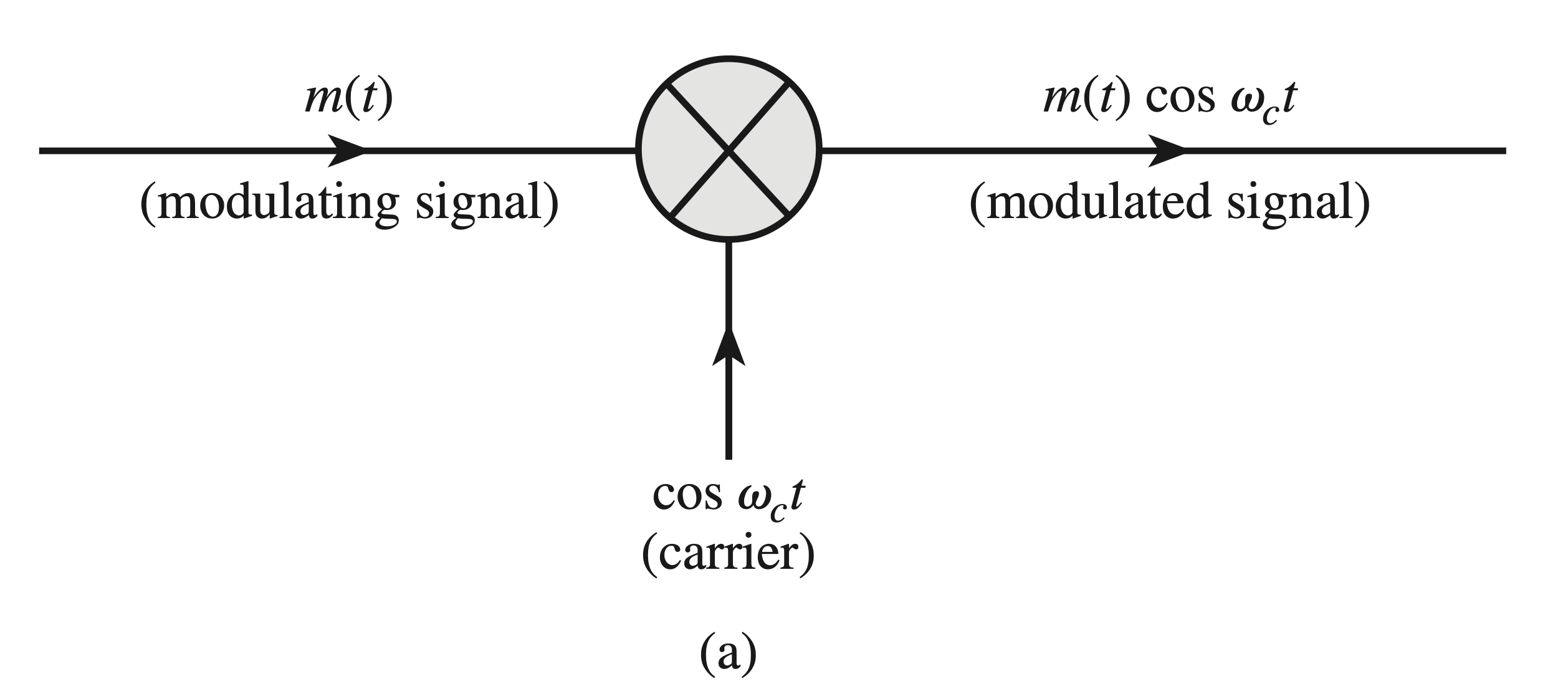
In DSB-SC modulation, given the baseband (message) signal
As was indicated earlier, using the Fourier transform, we have
where
Thus, if
then
Thus, the process of modulation shifts the spectrum of the modulating signal to the left and the right by
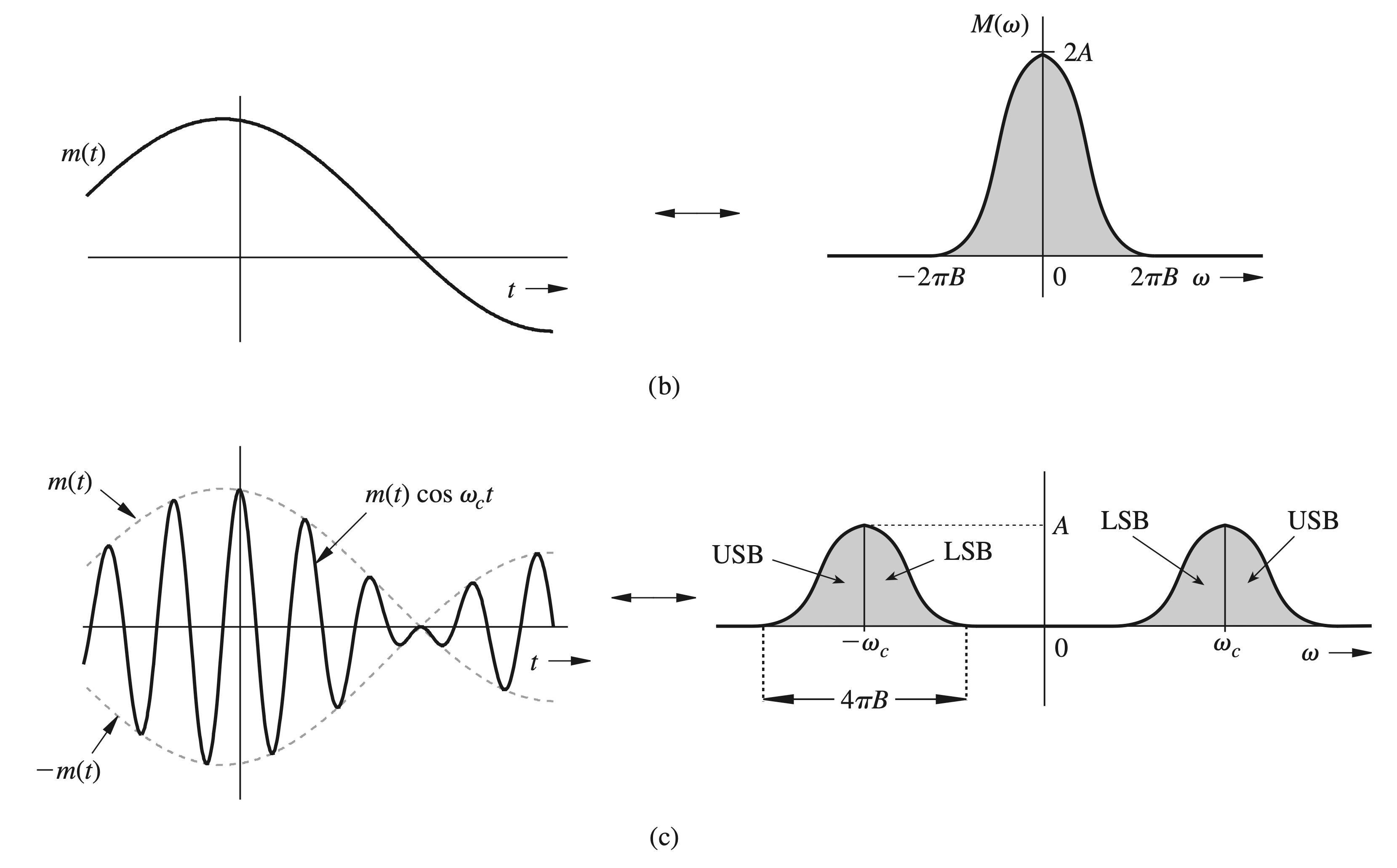
We also observe that the modulated signal spectrum centered at
- a portion that lies above
- a portion that lies below
Similarly, the spectrum centered at
Meanwhile, Figure 7.36c shows that, to avoid the overlap of the spectra centered at
Demodulation of DSB-SC signals
The process of recovering the signal from the modulated signal (retranslating the spectrum to its original position) is referred to as demodulation, or detection. For DSB-SC signals, the demodulation method is called synchronous detection, or coherent detection,
As seen from
- Retranslate the spectrum to its original position. This is done by multiplication of the incoming modulated signal
- Supress the unwanted spectrum at
The process is depicted in Fig. 7.38a.
NOTE:
- After demodulation, we get
- This demodulation method is called synchronous detection, or coherent detection, since we use a carrier (
- In reality, a transmitter that may be located hundreds or thousands of miles away. This situation calls for a sophisticated receiver, which could be quite costly. Therefore, in practice we shall use the so-called amplitude modulation (AM) method.
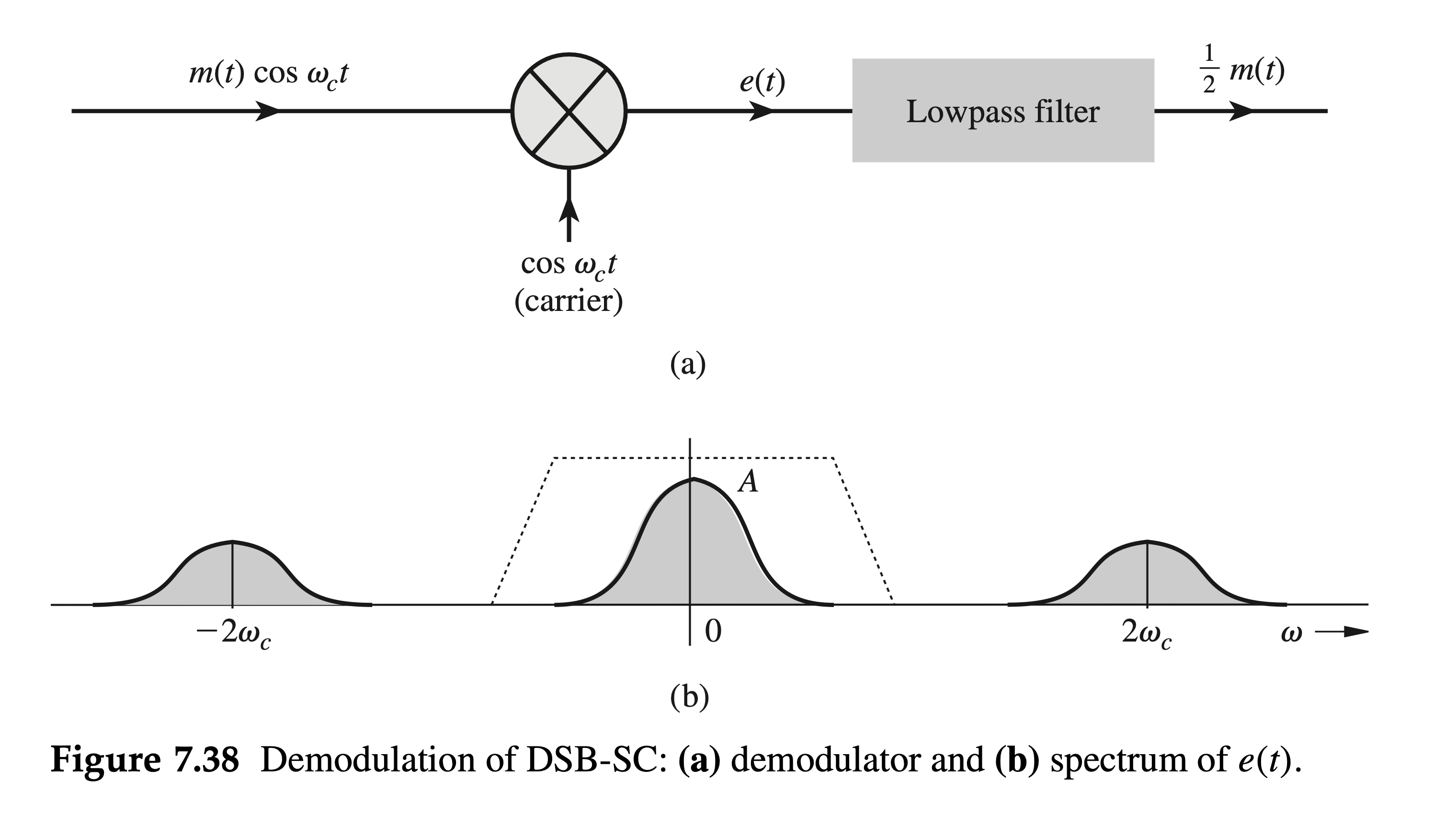
Mathematically speaking, in the first step we are computing the signal
whose Fourier transform is
Hence,
The spectrum of the second component, being a modulated signal with carrier frequency
After that, we get the desired component
Amplitude modulation (AM)
To avoid the overhead of generate a carrier in frequency and phase synchronism with the carrier for a receiver as in DSB-SC modulation, we opt to let the transmitter to transmit a carrier
This is amplitude modulation (AM), in which the transmitted signal
Recall that the DSB-SC signal is
To sketch
- In the first case,
- In the second case,
In the first case, the envelope (Fig. 7.39d) has the same shape as
In the second case, the envelope shape is not
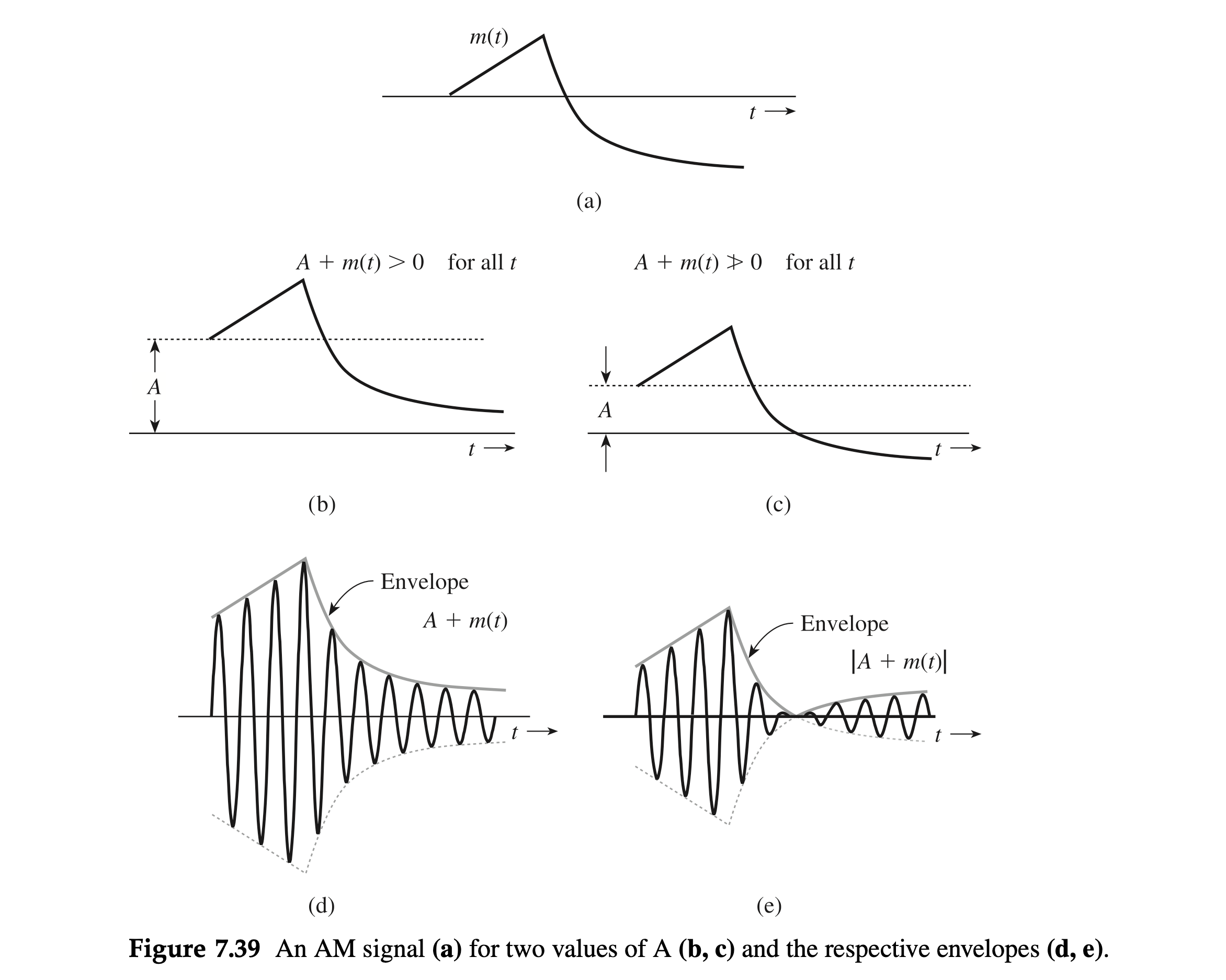
Demodulation of AM signals
From the last section, we know that we can detect the desired signal
The demodulation ethod for AM signals is called envelope detection. We shall see that it's an extremely simple and inexpensive operation since it does not require generation of a local carrier for the demodulation.
But as just noted, the requirement
If
Thus, the minimum carrier amplitude required for the viability of envelope detection is
Single-Sideband, Suppressed-Carrier (SSB-SC) modulation
Now consider the baseband spectrum
 Clearly, it is redundant to transmit both sidebands. A scheme in which only one sideband is transmitted is known as single-sideband (SSB) transmission, which requires only half the bandwidth of the DSB signal. Thus, we transmit only the upper sidebands (Fig. 7.42c) or only the lower sidebands (Fig. 7.42d).
Clearly, it is redundant to transmit both sidebands. A scheme in which only one sideband is transmitted is known as single-sideband (SSB) transmission, which requires only half the bandwidth of the DSB signal. Thus, we transmit only the upper sidebands (Fig. 7.42c) or only the lower sidebands (Fig. 7.42d).
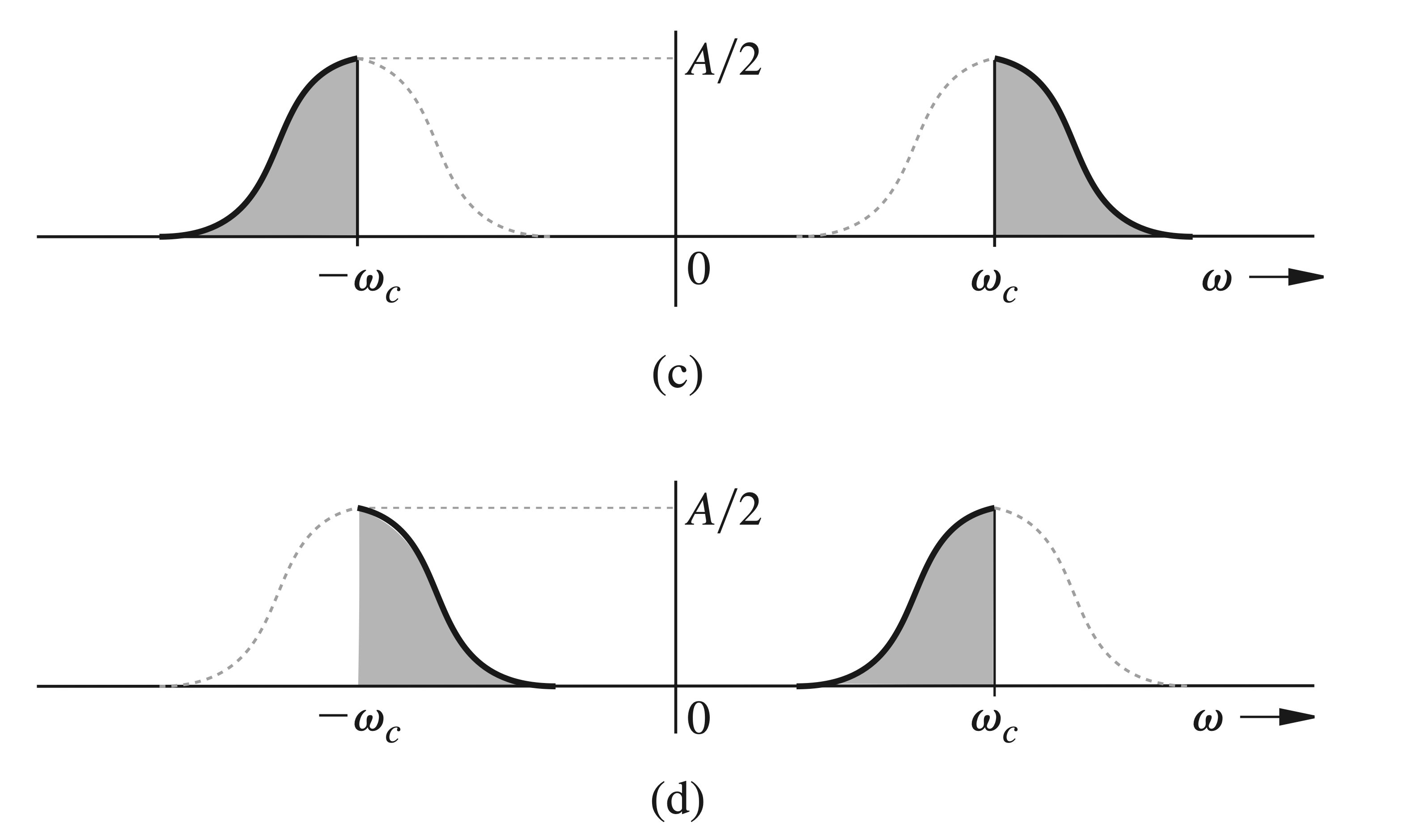
Demodulation of SSB-SC signals
An SSB signal can be coherently (synchronously) demodulated. For example, multiplication of a USB signal (Fig. 7.42c) by
 Lowpass filtering of this signal yields the desired baseband signal. The case is similar with an LSB signal. Hence, demodulation of SSB signals is identical to that of DSB-SC signals, and the synchronous demodulator in Fig. 7.38a can demodulate SSB signals. Note that we are talking of SSB signals without an additional carrier. Hence, they are suppressed-carrier signals (SSB-SC).
Lowpass filtering of this signal yields the desired baseband signal. The case is similar with an LSB signal. Hence, demodulation of SSB signals is identical to that of DSB-SC signals, and the synchronous demodulator in Fig. 7.38a can demodulate SSB signals. Note that we are talking of SSB signals without an additional carrier. Hence, they are suppressed-carrier signals (SSB-SC).